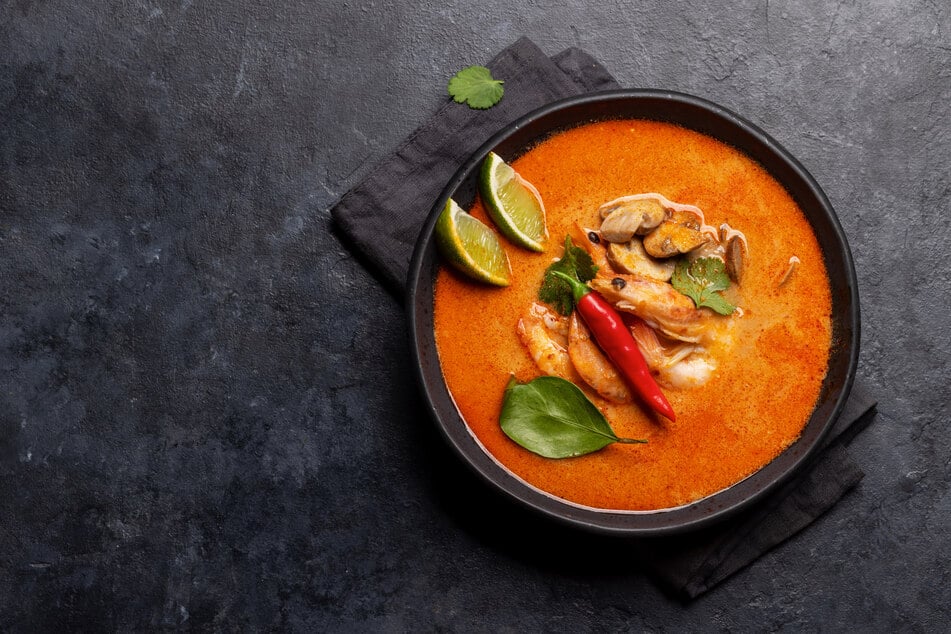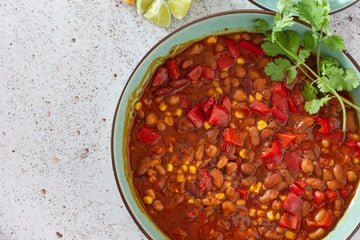How to make Thai red curry: An easy and fun recipe
Thai red curry brings the heat, the tang, and the sweetness that we all crave. When made at home, it's a healthy, delicious, and easy choice. Here's how to do it.

Many people shy away from making take out staples like red curry at home, falsely assuming that such dishes are difficult to put together, or require expensive and hard-to-find ingredients.
In most cases, though, these fears are alleviated by simple and easily thrown-together recipes.
A good Thai red curry is much the same, made up of simple and relatively easy-to-find ingredients that you can get from most supermarkets.
How do you make Thai red curry, though? Well, with this recipe, of course!
What is Thai red curry?
A Thai red curry is a dish characterized by the use of red curry paste and coconut milk to make a flavorful soup-like curry. While it commonly includes duck or shrimp as the principle protein, it can also be made with chicken, pork, beef, or even vegetarian ingredients like tofu. In addition, red curry usually includes a variety of different vegetables.
While it can be made with a thicker consistency, it is usually a looser soup-like broth with the other ingredients suspended in the intensely flavorful curry. Red curry is typically served on a bed of fluffy rice, sometimes alongside flat breads or typical Thai starters. It is eaten hot, and can often be very spicy.
Red curry is, perhaps, one of the most commonly consumed Thai dishes in the world, second only to Pad Thai. Often served very mild and slightly sweet, it is a beautiful curry that can be made kid-friendly and packed full of nutrients.
How to make easy and authentic Thai red curry
Other than getting the right ingredients, the construction of a Thai red curry is surprisingly straight forward. All you really need is a large heavy-bottomed pot and a way to cook rice. It doesn't require much in terms of skill or attention to detail, just a few basic measurements and a lot of throwing stuff into a pot.
Here's the equipment you'll need when making Thai red curry:
- A large, deep pot (preferably a Dutch oven)
- Sharp knives
- Chopping board
- Oven
- Frying pan
- Big spoon
- Measuring equipment
- Rice cooker or small pot
As you can tell, there's very little needed for a good Thai red curry. The most important thing is the pot, which needs to be big enough.

Thai red curry recipe | Ingredients
While there are a few herbs, sauces, and pastes here that may seem a little unusual, there is no ingredient that you won't find in the Asian food section of any normal supermarket. On top of that, nothing is particularly expensive. The only space where you might end up spending a bit more is the cut of meat you choose.
Here are the ingredients you need to make Thai red curry:
- Protein (duck, pork, beef, chicken, or shrimp), of your choice
- Red curry paste, 3–4 ounces (to taste)
- Large can of lychees (in juice), 15-20 oz
- Lime juice, 1/2 cup
- Fish sauce, 1/4 cup
- Snow peas
- 2 large carrots
- Coconut milk or cream, 4–5 cups
- Thai basil
Cilantro
- Salt
- Pepper
- Butter
- Cooking oil
- Rice (however much you want)
On the proportions: We have designed this recipe to feed four, with no leftovers. Of course, this will depend on the size of each serving. If you need to make more or less, adjust the quantities proportionally.
Thai red curry recipe | Instructions
In terms of the actual method here, it's all pretty basic and just a matter of throwing stuff in a pot (admittedly, in the right order). Try not to worry too much - Thai red curry is the name of the game when it comes to easy and quick cooking.
How to make Thai red curry:
Step 1: Chop and prepare everything, making sure that your carrots are sliced thinly, your herbs and peas washed well, and all of your other components are measured out and ready to go.
Step 2: Start by getting your protein cooking. Assuming you use duck breast, season all sides with salt and pepper and place into a cold frying pan, seasoned with a cooking oil, skin-side-down. Bring the heat up gradually, to render out the fat and crisp up the skin. Once crispy and golden, sear all other sides and place into a pre-heated 365°F oven for 30 minutes. Cook any other protein exactly the same way (except for shrimp - simply season and fry them off).
Step 3: Get your rice cooking.
Step 4: In the large pot, add a healthy stick of butter and melt it down over a medium heat. Add your red curry paste and fry off until fragrant.
Step 5: Add the coconut milk and mix thoroughly, bringing it slowly to the boil. Simmer for 4–5 minutes and then add your lime juice, fish sauce, and the can of lychees (including the juice). Bring it all to the boil and cook for another 4–5 minutes.
Step 6: Add all your chopped vegetables and make sure that the flavor is okay, seasoning to taste. Cook it all for at least 10–20 minutes, or until the carrots are soft but not mushy.
Step 7: Having cooked your meat, take it out of the oven and let it rest for at least 5–10 minutes. Slice it into strips.
Step 8: Serve by making a bed of rice at the bottom of the bowl. Place your sliced meat on top and then pour over healthy amounts of the curry. Garnish with Thai basil and cilantro.
Important: Make sure to adjust the amount of red curry you use to the taste buds of those you are feeding. In particular, make sure that you know how well your friends and family handle spice - too much red curry paste can make it extremely spicy!
Vegetarian or vegan Thai red curry recipe

It can be a little bit difficult to make vegan or vegetarian red curry, mainly on account of the paste itself. As you will see in the section we have on red curry paste, it includes shrimp paste, which obviously won't fit the bill. It's still possible, though, so we've got two additional steps for you.
Here's how to make Thai red curry vegetarian or vegan
Replace the paste: Find yourself a red curry paste that has been labeled as vegan or vegetarian, and check the ingredients to make sure that all is fine. Try out a few to find one that is tasty. Alternatively, make your own red curry paste and simply leave out the shrimp paste. If you still want that umami hit, though, add a pinch of MSG to the paste instead.
Replace the meat: This one is simple. Instead of using a meat or seafood, cook up some tofu or add a few extra vegetables to thicken up and fill out the curry. Potatoes are a great choice, but you could even use things like chickpeas.
It's perfectly fine to make red curry without the use of animal products, and you can make something that still tastes amazing.

What is in Thai red curry paste?
While Thai red curry paste can be purchased from most supermarkets in small jars labeled with various ingredients and dosing sizes, you can also make it at home. It will take a little while to make, of course, as you need to grind everything into a paste, but with just a mortar and pestle and the ingredients in question, you'll produce something that'll taste far better than the store-bought stuff.
Here are the ingredients for Thai red curry paste:
- Ginger, thumb-sized knob
- 2 lemongrass stalks
- 2 cloves of garlic
- 5 red chilies (or less, if you're afraid)
- Shrimp paste, 1 teaspoon
- Galangal, thumb-sized knob
- Turmeric, 1-inch knob
- Lime juice, 1 tsp
- 1 lime leaf
- 1 red shallot
- Coriander seeds, 1 tsp
- Salt (to taste)
To prepare the red curry paste, simply smack it into a large mortar and pestle and pound it until completely obliterated. It is better to do it this way than with a blender, as it will bring out the flavors much better.
Thai red curry is a delicious and easy meal to make at home
It might seem tempting to run off to your local Thai place, or even order-in out of sheer laziness, but few things are as fun and enjoyable to make than a good red curry. The smell of the roasting red curry paste is incredibly powerful, but also incredibly satisfying, and when combined with the beautiful sweet fumes from the coconut milk, you'll be salivating far before the dish is ready.
What makes it all the better, though, is that Thai red curry can generally be slapped together in about half an hour, and is incredibly easy to make. You don't really need to make your own red curry paste, either, the stuff from the supermarket is completely fine and will do the job easily. If you do want to be more creative, though, you can pick up even better red curry pastes from most Asian supermarkets.
So get out your pots and pans and make a red curry worthy of champions. It'll keep the kids and friends happy, it'll keep you happy, and it'll certainly keep the wallet happy, too.
Cover photo: 123RF/Karandaev



